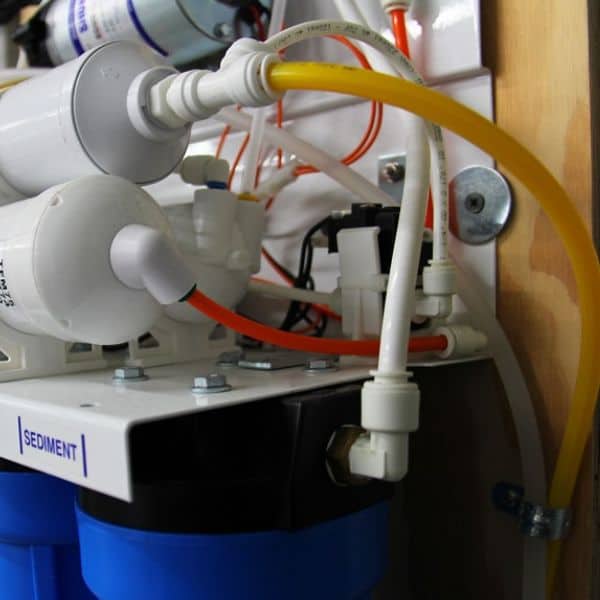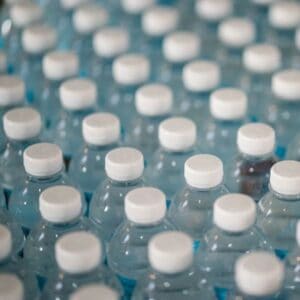How Does Reverse Osmosis Remove Water Contaminants?
Pressure forces source water first into a sediment pre-filter that removes the suspended particles and then into one or two carbon pre-filters that eliminate chlorine and organic compounds. The water then enters the reverse osmosis membrane, allowing water molecules to pass through but rejecting atoms from heavy metals and molecules from other contaminants.
The contaminants rejected by the RO membrane constitute the brine or reject (also referred to as wastewater) and are sent to the drain line. On one side of the membrane is the purified water, which is then stored in the RO tank, ready for consumption.
When the lever faucet is opened, the reverse osmosis water goes through the last stage, called the post-filtration, which uses a carbon filter to polish the water—eliminating unwanted taste and odor. In this last stage, some RO systems have a remineralization filter to remineralize RO water to regain the lost essential minerals.
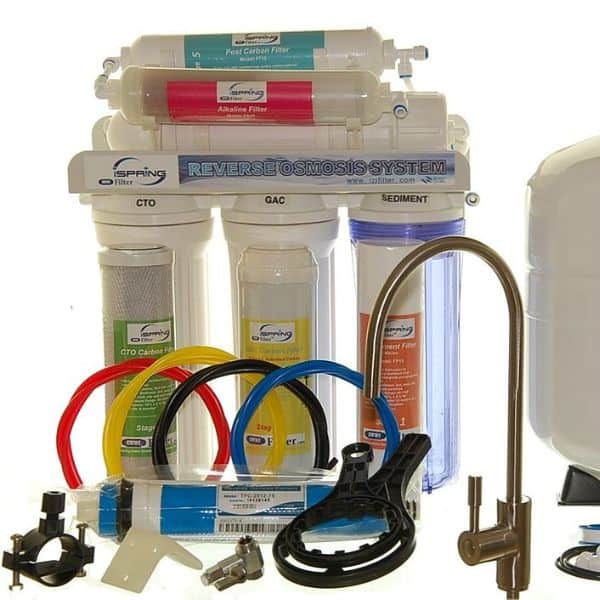
What Are the Contaminants That Reverse Osmosis Removes?
Does RO work in eliminating contaminants from drinking water? For many years, reverse osmosis has proven unparalleled in removing water contaminants in a cost-effective method.
The following are different contaminants that RO systems remove from tap water.
Harmful microorganisms
Reverse osmosis systems can remove up to 99.99 % of microorganisms in water, such as bacteria, fungi, viruses, and protozoa. These pathogens cannot pass through the RO membrane with a micron rating of size 0.0001.
Bacteria
Reverse osmosis removes bacteria. Smaller than pathogenic fungi, bacteria vary in size and are mostly 0.2 microns in diameter and 2−8 microns in length. Common bacteria found in water supplies, such as Salmonella, E.Coli, and Shigella, which all cause diarrhea can be eliminated using reverse osmosis.
Viruses
Ro system also removes viruses. Viruses, the smallest of all microorganisms, have diameters ranging from 0.02 to 0.25 microns. The Norovirus, also known as the stomach bug, has a diameter of 0.027 microns (0.27nm). This small but terrible virus has caused 19-21 million cases of acute gastroenteritis annually in the US and has caused hundreds of deaths—mostly young children and older adults.
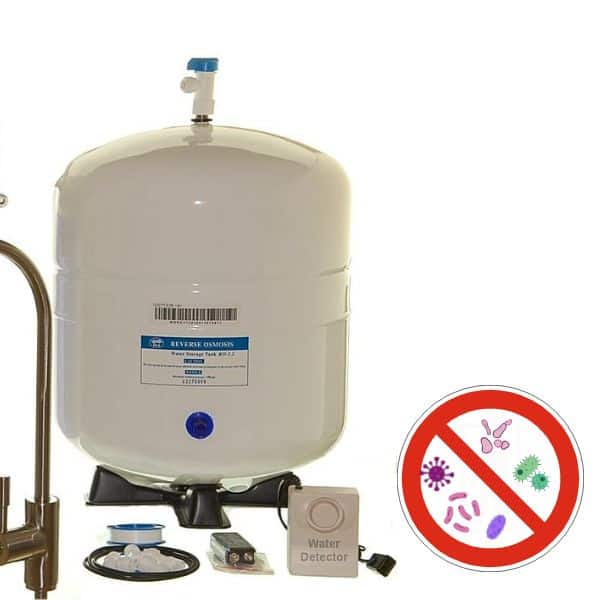
Fungi
Smaller than protozoans, pathogenic fungi typically measure 5-10 microns. Two of the most common fungi found in untreated water are the genera Penicillium and Aspergillus. Some species of their kind can cause allergic reactions, infections, and organ damage.
Protozoa
The biggest microorganism, protozoans, usually measure less than 50 microns in size. One protozoan found in untreated water is Giardia duodenalis (or Giardia lamblia) which measures 10-20 microns. They can cause Giardiasis—a type of diarrheal infection- one of the most common waterborne diseases in the US.
Heavy Metals
Most RO systems can remove up to 99% of heavy metals. After the water flows from the carbon prefilters, where chlorine, suspended solids, and pesticides are removed, the water then flows to the RO membrane. Here, the atoms of heavy metals are rejected by the RO membrane.
As seen in the table below, the EPA has set a maximum contaminant level (MCL) for some of these heavy metals due to their impact on human health.
| Heavy Metal | MCL (mg/L or ppm) | Some Effects of Long-Time Exposure Above the MCL |
| Arsenic | 0 | Increased risk of cancer |
| Antimony | 0.006 | Increase of blood cholesterol |
| Barium | 2 | Increase in blood pressure |
| Beryllium | 0.004 | Intestinal lesions |
| Cadmium | 0.005 | Kidney damage |
| Chromium | 0.1 | Allergic dermatitis |
| Copper | 1.3 | Liver and kidney damage |
| Iron | 0.3 | Stomach problems |
| Lead | 0 (0.015 with treatment technique) | Kidney problems |
| Mercury | 0.002 | Kidney damage |
| Thallium | 0.0005 (0.002 with treatment technique) | Kidney, intestine and liver problems |
Other elements
Like heavy metals, the atoms of other elements are also rejected by the RO membrane allowing only pure water molecules to pass through. RO systems are capable of removing 90-99% of the contaminants listed below, which include healthy minerals:
- Calcium
- Chloride
- Flouride
- Selenium
- Sodium
- Manganese
- Magnesium
- Radium
- Potassium
- Zinc
Volatile Organic Compounds
Volatile Organic Compounds (VOCs) are organic chemicals emitted as gases in the air. Common VOCs in water are Trihalomethane, Formaldehyde, Hexane, and Xylene. They are used in many products, such as aerosol sprays, paint, and other personal care items. Exposure to these chemicals can cause both short and long-term health risks.
In an RO system, it is not the RO membrane that removes VOCs but the carbon prefilters. Since VOCs are gases, they are better absorbed by a carbon filter through adsorption.

Pharmaceuticals
Reverse osmosis systems (RO) can also remove pharmaceuticals from drinking water supplies. While the US EPA has not yet established limits for pharmaceuticals in drinking water, it is still safe to consider removing them.
Pharmaceuticals have been detected in trace amounts in groundwater worldwide over the past two decades. These drugs can come from various sources, such as wastewater treatment plants or septic tanks that leach into nearby rivers and streams. Following are the pharmaceuticals which RO systems can remove:
- Antibiotics
- Anabolic Steroids
- Carbamazepine (Anticonvulsant)
- Diazepam (Sedative)
- Diclofenac and Ibuprofen (NSAID)
- Hydrochlorothiazide
- Metoprolol and Atenolol
- Paracetamol (Tylenol)
Pesticides
Pesticides comprise a complex mixture of chemicals used to eliminate or repel pests in agricultural production and home landscaping. Unfortunately, these products can find their way into drinking water sources over time due to runoff and residual presence in soil on plants that eventually make their way into streams and rivers.
RO membranes alone cannot remove pesticides in water. For this reason, most RO systems incorporate carbon prefilter to do the job. Pesticides such as Endrin, Heptachlor, and Lindane can be removed by reverse osmosis, but atrazine requires a carbon filter.
Other Contaminants
Hydrogen sulfide
Usually a by-product of industrial processes such as mining, food processing, and rayon manufacturing, hydrogen sulfide (H2S) is a colorless poisonous gas that smells like rotten eggs. This harmful gas can irritate one’s respiratory system, although the EPA has not established the MCL hydrogen sulfide.
RO membranes do not remove hydrogen sulfide. Like VOCs, hydrogen sulfide is better filtered by a carbon block or activated carbon which is a pre-filter in most RO systems.
Nitrates
Nitrates are forms of nitrogen in the environment, either natural or man-made. High nitrate levels in drinking water may increase the risk of colon cancer and other illnesses. For this reason, EPA has set the maximum contaminant level of nitrates at 10 mg/L. RO systems can remove 83-92% of nitrates in your tap water.
Sulfates
Water that flows through rock and soil that contain sulfate minerals will have a high sulfate content. Sulfate content has to be reduced to 250 mg/L as too much sulfate can make water taste bitter. Thankfully, RO removes 93-99% of sulfates in water.
Asbestos
RO membranes can remove 99% of asbestos in drinking water. This group of fibrous minerals to fireproof materials is usually found in vinyl flooring, wall and ceiling insulation, and fire-retardant clothing. Exposure to these harmful substances can cause larynx, ovary, and lung cancer. For healthy and safety purposes, EPA has set the maximum contaminant level for asbestos at 7 MFL.
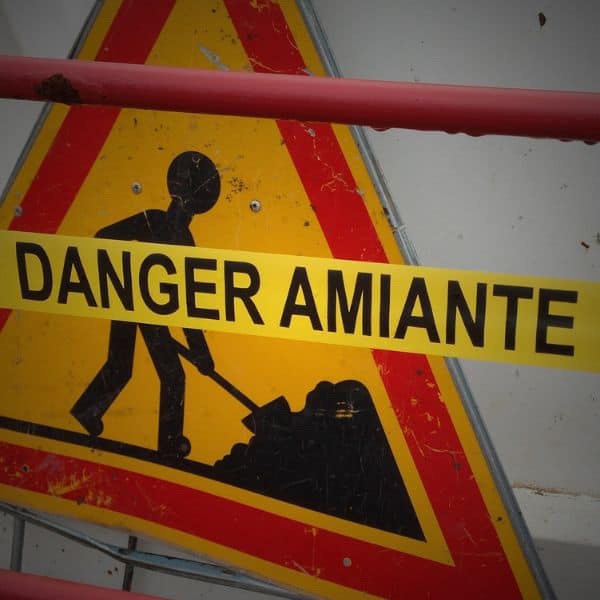
Reverse Osmosis Reduces TDS Levels in the Water
Total Dissolved Solids (TDS) consist of inorganic salts, minerals like sodium, calcium, magnesium, potassium, chloride, sulfate, and bicarbonate in water.
EPA has set a secondary standard for TDS at 500 mg/L to keep the water’s aesthetic effects yet safe for consumption. High TDS levels should be analyzed for heavy metals and toxic particles. Once these contaminants have been removed, your water will be much purer and safer to drink.
Aside from deionization and distillation, reverse osmosis is a proven method to reduce TDS in water. Its RO membrane rejects the atoms and molecules of contaminants— leaving them in the brine or concentrate and sending them down the drain.
In addition to improving the taste of your tap water, reducing its TDS levels can also provide numerous health benefits such as improved digestion and absorption of nutrients.
Conclusion
So what does reverse osmosis remove from drinking water? Well, reverse osmosis is a very effective technology for removing contaminants from drinking water. The common contaminants removed by reverse osmosis include bacteria, heavy metals, VOCs, and pesticides.
In addition, reverse osmosis also reduces the total dissolved solids (TDS) and improves the taste of your tap water. Overall, reverse osmosis is an excellent technology for removing impurities from your tap water.
